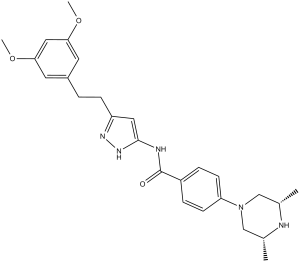AZD4547
This product is for research use only, not for human use. We do not sell to patients.

For small sizes, please check our retail website as below: www.invivochem.com
| Size | Price | Stock |
|---|---|---|
| 500mg | $550 | Check With Us |
| 1g | $900 | Check With Us |
| 5g | $2280 | Check With Us |
Cat #: V0616 CAS #: 1035270-39-3 Purity ≥ 98%
Description: AZD4547 (AZD-4547; AZD 4547) is a novel and orally bioavailable FGFR (fibroblast growth factor receptor) inhibitor with potential antineoplastic activity.
Top Publications Citing Invivochem Products
Publications Citing InvivoChem Products
Product Promise

- Physicochemical and Storage Information
- Protocol
- Related Biological Data
- Stock Solution Preparation
- Quality Control Documentation
| Molecular Weight (MW) | 463.57 |
|---|---|
| Molecular Formula | C26H33N5O3 |
| CAS No. | 1035270-39-3 |
| Storage | -20℃ for 3 years in powder formr |
| -80℃ for 2 years in solvent | |
| Solubility In Vitro | DMSO: 92 mg/mL (198.5 mM)r |
| Water: <1 mg/mLr | |
| Ethanol:<1 mg/mL | |
| Solubility In Vivo | 4% DMSO+30% PEG 300+5% Tween 80+ddH2O: 5mg/mL |
| SMILES Code | O=C(NC1=NNC(CCC2=CC(OC)=CC(OC)=C2)=C1)C3=CC=C(N4C[C@H](C)N[C@H](C)C4)C=C3 |
| Synonyms | AZD-4547; AZD 4547; AZD4547; |
| Protocol | In Vitro | AZD4547 also inhibits recombinant VEGFR2 (KDR) kinase activity with an IC50 of 24 nM. In KG1a, Sum52-PE, MCF7, and KMS11 cell lines, AZD4547 potently inhibits autophosphorylation of FGFR1, 2, and 3 tyrosine kinases (IC50 values of 12, 2, and 40 nM, respectively) and displays weaker inhibition of FGFR4 cellular kinase activity (IC50=142 nM). Significantly weaker inhibitory activity is observed versus cellular KDR and IGFR ligand-induced phosphorylation (IC50 values of 258 and 828 nM, respectively), representing approximately 20- and 70-fold selectivity over cellular FGFR1. Besides, AZD4547 potently inhibits FGFR phosphorylation and downstream signaling affected through FRS2, PLCγ, and MAPK at the cellular level. |
|---|---|---|
| In Vivo | Female SCID mice bearing KMS11 tumors are randomized and treated chronically with AZD4547 at a range of well-tolerated doses. Oral AZD4547 treatment results in dose-dependent tumor growth inhibition. Twice daily administration of AZD4547 at 3 mg/kg gives statistically significant tumor growth inhibition of 53% (P<0.0005 by one-tailed t test) when compare with vehicle-treated controls, whereas doses of 12.5 mg/kg once daily and 6.25 mg/kg twice daily results in complete tumor stasis (P<0.0001). A further efficacy study in the KG1a model with 12.5 mg/kg once daily AZD4547 results in 65% tumor growth inhibition (P=0.002). |
These protocols are for reference only. InvivoChem does not
independently validate these methods.
| Solvent volume to be added | Mass (the weight of a compound) | |||
|---|---|---|---|---|
| Mother liquor concentration | 1mg | 5mg | 10mg | 20mg |
| 1mM | 2.1572 mL | 10.7859 mL | 21.5717 mL | 43.1434 mL |
| 5mM | 0.4314 mL | 2.1572 mL | 4.3143 mL | 8.6287 mL |
| 10mM | 0.2157 mL | 1.0786 mL | 2.1572 mL | 4.3143 mL |
| 20mM | 0.1079 mL | 0.5393 mL | 1.0786 mL | 2.1572 mL |
The molarity calculator equation
Mass(g) = Concentration(mol/L) × Volume(L) × Molecular Weight(g/mol)
Mass
=
Concentration
×
Volume
×
Molecular Weight*
The dilution calculator equation
Concentration(start)
×
Volume(start)
=
Concentration(final)
×
Volume(final)
This equation is commonly abbreviated as: C1 V1 = C2 V2
Concentration(start)
C1
×
Volume(start)
V1
=
Concentration(final)
C2
×
Volume(final)
V2
Step One: Enter information below
Dosage mg/kg
Average weight of animals g
Dosing volume per animal µL
Number of animals
Step Two: Enter the in vivo formulation
%DMSO
+
%
+
%Tween 80
+
%ddH2O
Calculation Results:
Working concentration:
mg/ml;
Method for preparing DMSO master liquid:
mg
drug pre-dissolved in
µL
DMSO(Master liquid concentration
mg/mL)
,Please contact us first if the concentration exceeds the DMSO solubility of the batch of drug.
Method for preparing in vivo formulation:
Take
µL
DMSO master liquid, next add
µL
PEG300, mix and clarify, next add
µL
Tween 80,mix and clarify, next add
µL
ddH2O,mix and clarify.
Note:
- (1) Please be sure that the solution is clear before the addition of next solvent. Dissolution methods like vortex, ultrasound or warming and heat may be used to aid dissolving.
- (2) Be sure to add the solvent(s) in order.




































